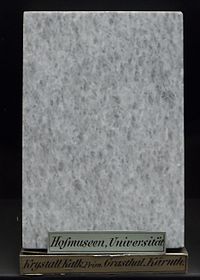Krastal marble


The Krastal marble occurs in the Millstättersee Mountains at its east end, in Carinthia (Austria) in the Krastal , a valley cut. In the middle of the Krastal there are quarries that were already used by the Romans. This marble was used in construction for centuries: six Roman pointed irons were found in the so-called Franz quarry, which are now exhibited in the Landesmuseum Klagenfurt.
Rock description and quarries
The Krastaler marble is a coarse-grained gray marble with a grain size of 3 to 5 millimeters. This natural stone contains phlogopite and lime and magnesia silicates . Krastal marble is clearly banded and is embedded in slate gneiss. This marble becomes lighter at the edge of the deposit. The corresponding reaction minerals are located at the storage limits of the marble on gneiss , pegmatite and amphibolite .
Quarries were operated by Della Schiava , Adami , Vogler , Fantoni , Leitner and Franz until the early 1950s . The Franz quarry was one of the largest and in the 1950s it was 90 meters long, 40 meters high and 30 meters deep on its hillside.
use
The Krastal marble is extremely weatherproof. Signs of weathering show up only in a slight roughening of the surface, which does not spread any further. The strength of this marble is so high that it was previously used as railway ballast.
In this deposit, the gaps are large, which is why rough blocks measuring 3.00 × 2.00 × 0.75 meters, slabs up to 8 m² and columns up to 3 meters in length can be extracted. It was used for monuments and tombs, wells and, above all, as stone for buildings.
Buildings and works of art
- Use of Krastal marble
Polygonal body by Leo Kornbrust in the Europapark Klagenfurt
Hermann monument on the Predilpass
Only a few examples of art monuments can be given here.
- Friesach : Medium large bowl of the market fountain (1563)
- Graz : Base of the Technical University and Karl Franzens University , opera house, finance building, district court, city theater, Archduke Johann monument
- Gurk : Gravestone Andreas Gösel (1688)
- Klagenfurt : State Museum, Maria Theresa Monument (1872), concert hall, weather pillar (1879)
- Kornat in the Lesach Valley : parish church and baptismal font (neo-Gothic)
- Lockenhaus : Nadasdy crypt under the parish church, sarcophagus of Count Lipot († 1873)
- Luggau : monastery, refectory, lavab0 (1657)
- Mallnitz : Villa Mojsisovics with numerous stone work
- Obervellach : memorial stone for Ingeborg Bachmann by sculptor Herbert Unterberger (2018)
- Predilpass : Hermann-Dankmal
- Puch : Parish church tower (1936)
- Sankt Martin bei Villach : Mörtenegg Castle
- Spittal : parish church, gravestones, war memorial, former Hotel Goldeck (1919/1911)
- Meeting : War Memorial
- Villach : Sankt-Jacob-Kirche, tower and gravestones; Nikolaikirche, tombstones outside; Millesi-Schlößchen (1625), gate walls; Town hall, door and window frames;
- Vienna : University, ramp and candelabra; Natural History Museum, base of the vestibule ; Art History Museum
- Winklern in the region valley : Roman stones, Carolingian architectural piece with ribbon ornament exhibited in the Lapidarium in the Museum Villach
- Zweinitz : Parish church, gravestone Andrä Hofmann von Wald (1507)
Öhringen partnership monument
literature
- Alois Kieslinger : The usable rocks of Carinthia. In: Carinthia II . Special issue 17, Verlag des Naturwissenschaftlichen Verein für Kärnten, Klagenfurt 1956, pp. 237–241 (full article pp. 1–348, PDF (368.3 MB) on ZOBODAT ).
Individual evidence
- ↑ New village square pays tribute to Ingeborg Bachmann. July 2, 2018, accessed July 24, 2019 .



